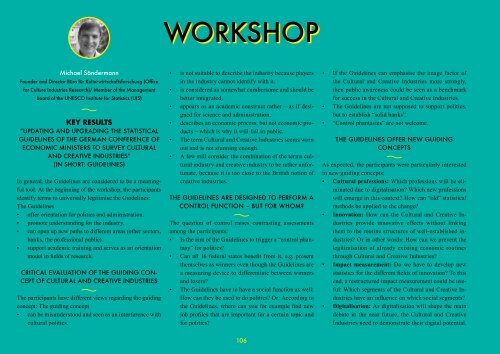DIGITAL IST KULTUR CULTURE IS DIGITAL – DIGITAL IS CULTURE
1n3RpM7
1n3RpM7
Erfolgreiche ePaper selbst erstellen
Machen Sie aus Ihren PDF Publikationen ein blätterbares Flipbook mit unserer einzigartigen Google optimierten e-Paper Software.
Michael Söndermann<br />
Founder and Director Büro für Kulturwirtschaftsforschung (Office<br />
for Culture Industries Research)/ Member of the Management<br />
Board of the UNESCO Institute for Statistics (U<strong>IS</strong>)<br />
KEY RESULTS<br />
“UPDATING AND UPGRADING THE STAT<strong><strong>IS</strong>T</strong>ICAL<br />
GUIDELINES OF THE GERMAN CONFERENCE OF<br />
ECONOMIC MIN<strong><strong>IS</strong>T</strong>ERS TO SURVEY CULTURAL<br />
AND CREATIVE INDUSTRIES”<br />
(IN SHORT: GUIDELINES)<br />
In general, the Guidelines are considered to be a meaningful<br />
tool. At the beginning of the workshop, the participants<br />
identify terms to universally legitimise the Guidelines:<br />
The Guidelines<br />
• offer orientation for politics and administration.<br />
• promote understanding for the industry.<br />
• can open up new paths to different areas (other sectors,<br />
banks, the professional public).<br />
• support academic training and serves as an orientation<br />
model in fields of research.<br />
CRITICAL EVALUATION OF THE GUIDING CON-<br />
CEPT OF CULTURAL AND CREATIVE INDUSTRIES<br />
The participants have different views regarding the guiding<br />
concept: The guiding concept<br />
• can be misunderstood and seen as an interference with<br />
cultural politics.<br />
• is not suitable to describe the industry because players<br />
in the industry cannot identify with it.<br />
• is considered as somewhat cumbersome and should be<br />
better integrated.<br />
• appears as an academic construct rather <strong>–</strong> as if designed<br />
for science and administration.<br />
• describes an economic process, but not economic products<br />
<strong>–</strong> which is why it will fail in public.<br />
• The term Cultural and Creative Industries seems worn<br />
out and is not stunning enough.<br />
• A few still consider the combination of the terms cultural<br />
industry and creative industry to be rather unfortunate,<br />
because it is too close to the British notion of<br />
creative industries.<br />
THE GUIDELINES ARE DESIGNED TO PERFORM A<br />
CONTROL FUNCTION <strong>–</strong> BUT FOR WHOM?<br />
The question of control raises contrasting assessments<br />
among the participants:<br />
• Is the aim of the Guidelines to trigger a “control phantasy”<br />
for politics?<br />
• Can all 16 federal states benefit from it, e.g. present<br />
themselves as winners even though the Guidelines are<br />
a measuring device to differentiate between winners<br />
and losers?<br />
• The Guidelines have to have a social function as well:<br />
How can they be used to do politics? Or: According to<br />
the Guidelines, where can you for example find new<br />
job profiles that are important for a certain topic and<br />
for politics?<br />
• If the Guidelines can emphasise the image factor of<br />
the Cultural and Creative Industries more strongly,<br />
then public awareness could be seen as a benchmark<br />
for success in the Cultural and Creative Industries.<br />
• The Guidelines are not supposed to support politics,<br />
but to establish “solid banks”.<br />
• “Control phantasies” are not welcome.<br />
THE GUIDELINES OFFER NEW GUIDING<br />
CONCEPTS<br />
As expected, the participants were particularly interested<br />
in new guiding concepts:<br />
• Cultural professions: Which professions will be eliminated<br />
due to digitalisation? Which new professions<br />
will emerge in this context? How can “old” statistical<br />
methods be applied to the change?<br />
• Innovation: How can the Cultural and Creative Industries<br />
provide innovative effects without linking<br />
them to the routine structures of well-established industries?<br />
Or in other words: How can we prevent the<br />
legitimisation of already existing economic routines<br />
through Cultural and Creative Industries?<br />
• Impact measurement: Do we have to develop new<br />
statistics for the different fields of innovation? To this<br />
end, a restructured impact measurement could be useful:<br />
Which segments of the Cultural and Creative Industries<br />
have an influence on which social segments?<br />
• Digitalisation: As digitalisation will shape the main<br />
debate in the near future, the Cultural and Creative<br />
Industries need to demonstrate their digital potential.<br />
106


